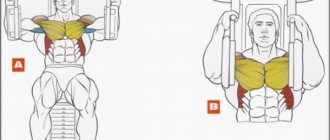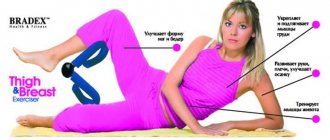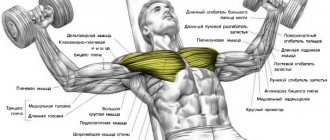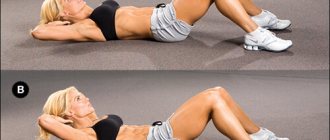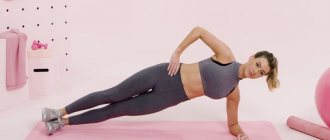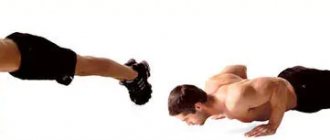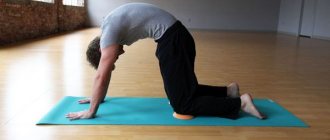Greetings, my dear readers, admirers and other individuals! It's time for a technical note on the ABCs of Bodybuilding, and today we will talk about raising arms in the simulator. After reading, you will learn everything about the muscle atlas, the advantages and technique of performing the exercise, we will also find out its effectiveness and the advisability of including it in the training program.
So, seatdown please, we begin.
Reduction of arms in the simulator (butterfly exercise)
What muscles work
- pectoralis major muscle: middle section, clavicular part
- coracobrachialis muscle
- biceps brachii: short head
Features of the exercise
The abbreviation of the arms in the simulator is an isolating exercise for working the middle bundle of the pectoralis major muscle. Other names for this exercise: butterfly, pec deck. Beginners (who are not at all prepared) will benefit from performing this relatively simple exercise until they are strong enough to begin technically more complex basic exercises (for example, bench press lying barbells).More advanced athletes can use this exercise at the end of a chest workout to work the pectoralis major muscle in isolation and achieve a pumping effect. The advantage of this exercise compared to a seemingly similar exercise with dumbbell flyes is that it maintains the load throughout the entire range of movement of the arms . In an exercise with dumbbells, the load disappears at the top point of bringing the dumbbells together, which makes the exercise less effective.
Execution technique
- Sit in the exercise machine. Keep your back straight. If necessary, adjust the seat back horizontally so that your back fits snugly against it.
- Grasp the handles of the levers in front of you. Your arms should be slightly bent at the elbows. Forearms are parallel to the floor. Adjust the seat height if necessary.
- The handles of the machine must be adjusted in such a way that even with the maximum extension of the arms back, the pectoral muscles remain tense under load at all times. That is, the load should remain suspended throughout the entire exercise, and not lowered onto the support at the end of each movement.
- Feet are wide apart and firmly on the floor. Look straight ahead. This is your starting position.
- As you exhale, begin to slowly bring your arms together, tightening your pectoral muscles.
- Bringing your hands as close to each other as possible, hold this position for a moment, thereby achieving a peak contraction of the pectoral muscles.
- As you inhale, begin to slowly spread your arms, returning to the starting position. Try to stretch your pectoral muscles as much as possible.
- Repeat the exercise a specified number of times.
There is another version of the simulator for performing the butterfly exercise. In it, your arms should be bent at the elbows at an angle of 90° and placed under the pillows. This exercise machine allows you to further isolate the pectoralis major muscle by excluding the biceps from the work.
Adviсe
- Try to work through the entire range of motion of your arms: from the moment when your arms are completely apart, the pectoral muscles are stretched to their maximum, and your shoulder blades are almost touching each other, until the moment when your arms are completely brought together.
- Make slow, controlled movements without jerking or using inertia. This will make the exercise more effective and safe.
proiron.ru
What kind of simulator is this
The butterfly (butterfly) simulator, or peck-deck, is a block power plant. It is a seat with a straight soft back and two movable arms for the arms. There are peck-decks with levers for outstretched arms, and there are those designed for arms bent at the elbows. The height of the bench is adjusted to the height of the athlete, as is the width of the hand rests so that they are positioned correctly.
The back can also change position: vertical or inclined. A load is attached to the back of the equipment, which is driven by hand force. The weight of the load can be increased as desired. The maximum load capacity of the simulator does not exceed 100 kg.
The advantage of this design is that the load is placed only on the pectoral and shoulder muscles. At the same time, the back does not strain, which absolutely eliminates spinal injuries.
Did you know?
The very first simulators were invented back in the 18th century for medicinal purposes. And the first gym appeared in Sweden a hundred years later on the initiative of the doctor Wilhelm Zander.
Reduction of arms in the butterfly simulator
Bringing your arms together in the butterfly machine is an exercise that works our favorite large pectoral muscles. It also includes the short head of the biceps, as well as the coracobrachialis muscles. It is recommended for beginners to perform the butterfly roll in the simulator. This is an isolating exercise, so it is advisable to perform it after basic exercises. If you use the pre-fatigue method, then you can perform the exercise before the basic one, pre-tiring the target muscle group.
TECHNIQUES FOR PERFORMING THE EXERCISE “ARM BENDING IN THE BUTTERFLY CHECK MACHINE”
1. Sit in the machine with your back straight, chest out, and shoulders relaxed. Place your forearms behind the machine's lever pads, keeping your elbows at shoulder level.
2. Inhale and bring your hands as close to each other as possible, while keeping your back straight and not bending.
3. Then smoothly return to the starting position, exhaling at the end of the movement.
TIPS ON EXERCISE TECHNIQUES
1. Despite the ease of performing this exercise, before increasing the load, you should become more familiar with and work out the technique of performing the exercise.
2. You cannot sharply move your arms to the side; always control your movements and make them slowly and smoothly.
3. Never hunch or round your shoulders during the exercise, and keep your chest open. If you can't stay in this position and have to hunch over to bring your arms together, it means you're carrying too much weight. Reduce the load and continue performing the exercise the required number of times and approaches.
4. To break up your workouts, you can use different variations of this exercise. It can be performed both in a cable trainer and with an expander.
We recommend paying attention to this exercise: Dumbbell bench press on a horizontal bench!
Sincerely, Site Administration!
www.buildbody.org.ua
What muscle bundles are involved?
As always, before any interesting exercise we look at the anatomy. This is necessary so that no questions arise during the course of the article.
Almost all people who work out in the gym make a mistake when training their shoulders. They actively pump the front and middle beams, but completely forget about the back. This can lead to muscle imbalances that can lead to shoulder injury.
Exercises for deltas must be planned and divided into three beams - front, middle and rear. The front deltoid looks beautiful in a T-shirt, the middle bun makes the deltoids more round and voluminous, while the back one is attached to the back muscles and creates a feeling of beautiful relief from the back.
Raising your arms in a simulator is popularly called a butterfly. Now that we've covered the anatomy, I'd like to talk about the benefits you'll get from making a butterfly.
Advantages of the butterfly simulator:
- Thanks to the correct technique, which we will look at a little later, you can form a rear delta bundle.
- Through regular shoulder training, to which you will add arm extensions in the simulator, you will be able to detail your back, making it more detailed and sculpted.
- You will be able to increase the muscle strength of the posterior deltoids, which will help in various basic exercises such as bench press, deadlift, and dips.
- You will develop the back part evenly with the rest of the buns, which will make your shoulders round.
Useless exercises that everyone does
Think about your standard gym routine for a second. Surely, after training you feel proud of yourself, because you worked such a large volume of muscles, you are a real champion of your gym. The exercises you perform are the best, proven over the years, and make your muscles grow by leaps and bounds. We're going to have to rock your world - a lot of the exercises everyone does aren't all that effective! Are you shocked? We, too. But, thank Cutler, useless exercises have excellent analogues. And so, the first exercise from our shameful list is...
1) Twisting on the floor.
The most standard and well-known exercise needs updating. This is the most ineffective exercise for pumping up the abdominal muscles, both the lateral ones and our favorite “cubes”. Lifting from a lying position uses only the muscles of the upper abs, and is also an unwanted load on the lower back.
Replacement - plank.
The plank exercise uses more abdominal muscles. Planking helps increase the endurance of your abdominal muscles. At first, you are unlikely to be able to stand in this position for more than 10 seconds, but regular exercises will improve the result to up to a minute. As a bonus, the plank reduces the possibility of future back pain.
2) Butterfly in the simulator.
To be fair, we note that this exercise really develops the chest muscles perfectly. But at the same time, it puts the shoulder joints in a very vulnerable position when he is simultaneously involved in arm extension and rotation. The exercise becomes especially dangerous for people with problems with the shoulder joint - in this case, butterfly can lead to serious injury with chronic consequences.
Replacement - bringing the hands together in a crossover.
The exercise uses the same muscles as the butterfly stroke in a machine, but does not cause any harm to your shoulder joints.
3) Bench press.
Research has shown that this exercise is ideal for developing the pectoral muscles and triceps. Unfortunately, the bench press also puts your shoulder joints at risk and often leads to shoulder injuries. The exercise also restricts the natural movement of the shoulder blades, putting enormous pressure on the rotator cuffs. Therefore, the bench press is considered unsafe by many fitness experts.
Replacement: push-ups.
Yes, yes, banal push-ups use the same muscles as the bench press. Push-ups can be modified in dozens of different ways, put stress on different muscle groups, and can be made more difficult or easier. Here you will find the most popular types of push-ups, from the simplest to the most difficult.
4) Push-ups from the bench from behind.
A good exercise to strengthen those hard-to-reach triceps muscles, but it's not for everyone. Due to the way your body is positioned during the exercise, back bench push-ups place a lot of pressure on your rotator cuffs and can cause chronic pain. People who already have problem shoulders should be especially wary of this exercise. Not sure if you have problems with your shoulder joints? Don't take risks and replace the back bench push-up with the following exercise.
Replacement: triangle push-up.
The exercise is suitable for all trainees and does not carry any risks. The triangle push-up engages not only the triceps muscles, but also the chest, shoulder and core muscles. This exercise is also often called the "gold standard" of triceps exercises, as it engages the most muscles with each triceps movement.
5) Pull-ups.
Pull-ups are familiar and loved by all of us since childhood. It was always fun to “hang on the horizontal bar.” The main difficulty of this exercise lies in the vertical hanging on straight arms, from which the exercise begins. Most people's shoulders are not flexible or strong enough to do this. Hanging vertically with straight arms puts a lot of pressure on the muscles and shoulder joints.
Replacement: pull-ups with emphasis.
Pull-ups develop your back muscles just as well as regular pull-ups, without putting unnecessary strain on your shoulders. In addition, chin-ups improve your posture and can help reduce or eliminate back pain.
6) Leg press.
A favorite exercise for many. After doing leg presses, your quads will quickly become engorged and you'll feel like the Incredible Hulk. But it is not as effective as we think. The leg press uses only one large muscle group, the movements you perform with it are not part of your daily activity, which means you will not increase the strength gained until your next trip to the gym. In simple words, the exercise is effective in the gym and for several hours after it, then the muscles deflate and the strength leaves them.
Replacement - lunges.
Lunges engage all the leg muscles and strengthen the core muscles. You can make lunges more difficult by adding additional weights. Plus: you perform lunges in your daily life when you climb stairs, which means your muscles will develop not only in the gym, but also on days without it.
www.powerpro.in.ua
How to replace a trainer that is busy – Om Activ
How to replace a trainer that is busy
Only amino acids are essential. So remember.
Leg press machine
Goal: Engage quadriceps, hamstrings, glutes
The simulator is better because it does not put any strain on the back. But if he’s busy and you’re having leg day, do squats with a ball or barbell.
The main thing is to squat with light weight so as not to overload your lower back.
When performing squats, make sure that your knees do not go beyond the line of your toes. Keep your back straight.
2. Hammer pectoral muscle trainer
Goal: Engage the pectoral (pectoral) muscles, triceps and shoulder girdle to increase their volume and mass
Hummer can be easily replaced with regular push-ups.
The simplest option is lying down with your knees touching. A more difficult option is full push-ups while lying down.
You can make the exercise even more difficult: change the height of your legs, so the load shifts from the stronger bottom of the pectoral muscles to their weaker top. Still not enough? Add weight to your back.
3. Exercise machine for bringing hands “Butterfly” (Butterfly)
Goal: Engage the pectoral muscles and shoulder girdle
Working in the “Butterfly” is an isolated exercise aimed at gaining relief and drawing the shape of the muscles. Therefore, we will replace it with an insulating analogue.
Grab some dumbbells and find a suitable bench. Perform the abduction and extension of your arms while lying down. It is useful to alternate the load on the lower and upper pectoral muscles, just by changing the angle of the bench.
Seated press machine
Goal: To engage the muscles of the shoulder girdle (deltoid - anterior, middle, posterior), triceps, trapezius
This machine is a multi-joint exercise designed to increase muscle mass in the upper body. In order to replace it you will need dumbbells and a bench. The bench can be supported or unsupported, which depends on the weight of the dumbbells and the quality of execution.
Perform dumbbell presses, simulating an exercise in a machine. But you will still feel a noticeable difference due to the need to maintain balance, because machines and free weights have different load delivery. We will talk about this in other articles.
5. Vertical row machine (wide row)
Goal: Engage the latissimus dorsi and biceps of the arms
This exercise is an isolating exercise. Pulls are performed both to the chest and behind the head. But head pulls are much more dangerous! It can only be performed by people with good mobility of the shoulder girdle or advanced athletes. I don't recommend it to beginners!
You can replace the vertical row machine by performing similar movements with elastic bands or expanders while bending over. The main thing is to keep your back straight.
6. Horizontal row machine (narrow row)
Goal: To engage the latissimus dorsi, biceps, and spinal extensor muscles.
Horizontal rows are performed to increase density and work the mid-back.
It is quite easy to replace it, without even loading the lumbar region.
Set the back of the bench at an angle of 35-45 degrees. Place your knees on the seat, rest your stomach and chest against the back of the bench. Ask for dumbbells and pull them towards your stomach.
Lying leg curl machine
Goal: Work the hamstrings, hamstrings and calf muscles
The replacement exercise is easy to do. But it will be difficult to prepare for it without outside help. You won't be able to secure the dumbbell between your socks yourself, so ask a trainer or gym partner to help. Concentrate on holding the apparatus and, just like in the simulator, perform leg curls.
In fact, work in simulators should be replaced with exercises with free weights, not only out of despair, but also for a full-fledged high-quality workout of all muscle groups. We will definitely talk about this in future articles.
The shooting took place at the Max Fitness fitness center
Address: Moskovsky Ave. 11/5, Chisinau, Moldova
Phone: 022442700/ 060400700
Share with your friends:
fitness instructor, exercise therapy specialist, senior trainer at “ZSport”
Popular articles
So how much water should you drink per day (no, not 2 liters)
The simplest formula from nutritionist Ekaterina Didyk. Don't be fooled by 8 glasses anymore.
12 tips: How to get rid of a beer belly, even for those who don’t drink beer
There is no advice to “stop drinking beer”, because it has nothing to do with it.
Review: 11 leading fitness clubs in Chisinau
There are a huge number of sports clubs in Chisinau: from basement rocking chairs to elite fitness centers, and choosing is not so easy.
10 foods that contain more sugar than you think
Nutritionist Ekaterina Didyk has done a great job for you. I didn’t just make a list, but clearly showed everything on the products that are sold here in Chisinau.
Reduction of arms in the “butterfly” simulator
The pectoral pinch is an isolation exercise designed to target the inner portion of the pectoralis major muscles. In this article we will look at performing this exercise in the “butterfly” simulator, otherwise it is also called the Pek-Dek simulator.
There are two types of this simulator:
- With elbow rests
- Without stops
Both options are good for bringing hands together, but they differ in technique.
By performing this exercise, you will not only strengthen your muscles, but also give them a beautiful relief. However, it is best to perform it in combination with other chest exercises, since by itself it does not provide much muscle growth.
Starting position: (Option with elbow rests) Sit in the machine, grab the handles. Press your elbows against the supports.
(Option without stops) Sit in the machine, grab the handles, and spread your elbows to the sides so that your arms are parallel to the floor.
Execution: Take a deep breath and, as you exhale, bring your hands together until they touch the handles of the exercise machine. As you inhale, raise your arms to the starting position.
Main mistakes when performing the exercise:
- Unadjusted height of seat and handles. It is necessary that your elbows are at shoulder height.
- Separation of the back and/or head from the back of the machine. Keep your head straight and look ahead.
- Incomplete reduction of hands. Do the maximum amplitude, but do not bring your elbows beyond the level of the body.
fitnesbody.ru
Recommendations
To make the work easier when performing the arm abduction exercise, you need to imagine that you are not pulling back the handles of the machine, but your own elbows. This way, you will be able to eliminate your hands from the work and use the target muscles more.
The body should be as motionless as possible during the exercise; try to fix it in one position. This will ensure greater execution efficiency and safety for you. When performing arm raises, proper breathing will allow you to produce a more powerful effort.
To maximize the involvement of the deltoid muscles, try to move your elbows behind your back as much as possible during the exercise. If you cannot do this, this means that you need to slightly reduce the weight of the projectile or develop greater flexibility in the shoulder joints.
Reduction of arms in the butterfly simulator
October 22, 2015 Admin Home page » Breast
The correct technique for the butterfly exercise, the muscles being trained, important recommendations and a video for correct execution are provided.
Another exercise for pumping up the pectoral muscles, popular among girls, and although it has been a little forgotten by the male sex in gyms and it is not as popular as the bench press, but this does not lose its effectiveness.
This is an isolating exercise, thanks to which the muscle fibers of the chest stretch and acquire a more distinct and attractive shape. Since using the “butterfly” virtually no mass is gained, it is recommended to do at least 12 repetitions and use it at the end of the pectoral muscle workout to “pump up” tired chest.
MUSCLES TRAINED
The main focus is on the external and internal parts of the pectoralis major muscle, the secondary focus is on the biceps. Regular use of the “butterfly” in the presence of pectoral muscles allows you to clearly draw a stripe between the right and left sides of the chest, giving the chest a sporty, beautiful look.
STARTING POSITION
To begin, adjust the seat correctly, placing it at such a height that when you grab the side levers with your hands, the elbow joints are at shoulder level, forming a 90° angle between the shoulder-elbow and the wrist.
Sit comfortably in the adjusted exercise machine, press the lever at the bottom with your foot, so you move the side levers of the machine closer to your body, lean the lower part of your inner forearms with your elbows against the special cushions on the levers, and grab the special handles with your palms.
The back and rear deltas are pressed tightly against the back of the exercise machine, the chest is protruded forward, the legs are on the floor, the heels are fixed, the head is looking straight, do not twist or tilt it forward, it is better to find a point in front of you and look at it from the beginning to the end of the exercise.
RECOMMENDATIONS
1) Do not take a lot of weight, this exercise is performed while observing a clear technique, if you break it you will not get any benefit, and by increasing the weight you will also harm yourself;
2) Be sure to press your shoulder blades and shoulders to the back of the seat when starting the movement; when your arms are closed, do not allow your shoulder blades and shoulders to come off the back, this will make the exercise easier, but the pectoral muscles will lose the load;
3) Before starting the exercise, set the seat height correctly so that when your hands are placed on the levers, your elbows are in the center of your chest + - 10 cm, but no more, this way you emphasize the load on the chest muscles.
4) Do not move your elbows too far back, this will overstrain your shoulders, which can injure them and the muscle recovery process will be delayed; the best option would be to spread your arms so that there is a straight line between the elbows of both hands.
5) From the initial position, exhaling, bring your elbows in front of you, until the two levers touch each other at this point, additionally tighten the chest muscles, spread the levers to the sides until you feel a stretch in the pectoral muscles and bring them together again.
6) Do not move your elbows back too far; if you feel pain in the shoulder joint and lumbar region, reduce the range of motion;
7) When bringing the levers together and spreading them, the pectoral muscles should always be tense from the first to the last second.
 And remember again, this is not a basic mass-building exercise for growing chest muscles, so choose the right working weight at which you can do 8-10 repetitions, no less. You can see all the exercises for the chest muscles here.
And remember again, this is not a basic mass-building exercise for growing chest muscles, so choose the right working weight at which you can do 8-10 repetitions, no less. You can see all the exercises for the chest muscles here.
VARIETY
Performed in a different simulator, the starting position and technique are described above, but there are differences:
With your hands on both sides of the simulator, take the handles of the levers with a closed grip, elbows at shoulder level, and the forearm parallel to the floor, from this position we bring our hands forward, preventing the levers from hitting each other, leaving a distance between them of approximately 10 cm.
Don’t forget to breathe correctly, exhale when mixing, inhale when relaxing. Do not place your elbows too far behind your shoulders, otherwise you will strain your shoulder muscles or damage your shoulder joint.
Tags: exercises
bombatelo.ru
Useful tips
1. Give the rear deltoid the same attention as the front or middle deltoid. Put the exercise last, or set aside a separate day to specifically pump up the rear deltoid. 2. During the exercise, try not to lift your torso from the seat bench, try to keep your back straight. 3. Hands should form an angle of 130 degrees. Do not bend or straighten your arms during the exercise - this way you will maintain maximum load. 4. Try to spread your elbows, not your arms, this will shift the load from your arms to your rear deltoids. 5. During the exercise, do not lower your elbows; they should always be parallel to the floor. 6. At the end point, try to hold for 1-2 seconds, additionally tensing your shoulder muscles. 7. Make sure you breathe correctly. 8. And of course, warm-up. There was a case when, due to the rush, the athlete did not warm up, and on the 3rd approach he received an injury - a sprain.
To achieve good results you need discipline, and of course desire. Set yourself a goal to gain weight in your shoulders, take measurements before, and after 2 months measure again and write down the results.
Can be measured every 2 weeks. Additionally, I recommend keeping a training diary where you will write down all the exercises and approaches that you performed.
Thanks to the diary and measurements, you can track your progress. At some point, you can see where you didn't work and fix it. The reverse butterfly is one of the main exercises for forming a beautiful rear deltoids. I recommend watching an interesting video that is informative. Be healthy!
bringing your arms together in the butterfly simulator
The butterfly exercise machine (Peck-Deck) is adapted to jointly develop the chest muscles. It consists of a bench divided into two parts: a back and a seat and working areas for the hands, one or the other, through a cable-roller arrangement, sets in motion a load consisting of a set of rectangular plates. The overload weight can be varied within a wide range; the maximum weight usually does not exceed one hundred kg. Exercises on this simulator are not difficult, because virtually no preparation is required, and it is virtually impossible to get injured. This is probably why it is a favorite among beginners, because it is still terrible to approach the barbell or dumbbells,
Performance technique
- Adjust the height of the seat of the Butterfly exercise machine for yourself so that sometimes you grab the handles, the upper arms are placed at the same level with the deltoids, and the elbows and forearms are firmly pressed against the soft exercise pads for the hands.
- Sit up straight and press your shoulder blades and bowler hat against the back of the machine. The legs must be positioned so that they are shoulder-width apart and the feet are positioned correctly under the knees, the angle at the knees must be open.
- Inhale and, while still breathing, bring the pads of your hands together in front of your chest. Exhale, sometimes master the most difficult part of the movement.
- Once you bring your elbows together as close as possible, stop for a couple of moments and try to tighten your chest muscles even more.
- Slightly weaken the chest muscles and allow the handles to slowly spread the elbows until they are in line with the deltoids or slightly behind the back.
- Next, stop and bring your elbows together again.
Adviсe
- Do not spread your elbows beyond the delts unless your shoulder joint is extremely stretched or if your chest muscles are weak and inelastic. Deflection of the elbows behind the back puts extreme stress on the shoulder joint and is dangerous.
- In order not to stretch the shoulder joint and, at the same time, to compress the chest muscles as much as possible, under no circumstances should you weaken them in the negative stage.
- Inhaling and stopping breathing during the process of mixing in the simulator strengthens the body position and increases mass. The back must be firmly pressed against the back of the projectile. This aligns the body and adds mass to the chest muscles.
Use
Intended for: Wholesale, from beginners to experts.
Other times: At the end of a workout on the chest muscles. At the beginning of the workout, do bench presses and fly-ups with dumbbells, and then start training in the butterfly simulator.
How much: 3-4 sets of 10-14 repetitions.
Sports instruction: Information in the butterfly simulator adds striping to the muscles of the chest; their inner edges highlight, correctly dividing the right and left great pectoral muscles in half of the torso. The mass of muscles involved in the exercise plays a major role in certain types of sports, such as gymnastics (when performing parts on the rings and free program on the mat), in boxing (various strokes), in baseball (punching), as well as in the execution of various strokes side view of an open racket in badminton, tennis and squash.
Interest: If the simulator has levers with a soft cushion, do not place your fingers on the back of the cushion; if the cable breaks, this can cause injury.
Video “Break the arms in the butterfly simulator”
To quickly lose weight, buy a treadmill. This will get you back in shape.
www.gymbaza.pro
execution technique. Exercises on exercise machines for men for the pectoral muscles
The professional “Butterfly” or “Butterfly” simulator (as it is popularly called) is a training device that can be used to work the muscles of the chest, shoulders, arms and even the abs. The athlete must perform swinging movements, spread and bring his arms bent at the elbows in front of him. It was thanks to these actions that the device received its name.
Description of models
Gym equipment can differ from each other in terms of mechanism. You can find quite simple devices in which the handles move due to a cable, rollers and weight. However, there are more complex machines that use a lever mechanism. But they all have one similar feature. The Butterfly trainer is equipped with a metal frame and two handles. The seat is attached to this frame.
At the present stage, you can see a variety of power devices that can simultaneously connect both the “Butterfly” simulator and a device for pumping leg muscles.
What muscles does the Butterfly exercise work?
- The upper and middle parts of the pectoral muscles (large muscles).
- Anterior deltoid muscle fibers.
- Triceps with biceps brachii.
- Oblique abdominal muscles.
- Serratus anterior muscles.
- Clavicular-brachial muscle fibers.
Features of the popular device
The Butterfly machine cannot be used as the only means of gaining weight. They will not be able to replace the barbell with dumbbells. In other words, exercises on this device are not considered basic, they are isolated. During the training process, mainly the chest muscles are involved in the work. According to many athletes, this is the main drawback of the device.
But regardless of this, the professional Butterfly simulator is quite popular among athletes. This is due to the fact that with its help the pectoral muscles can be brought to perfection, as well as the biceps and triceps. In addition, when lifting a barbell, for example, there is vibration in the arms, which this simulator does not have. For this reason, the muscles will receive a strictly defined load.
Professional athletes resort to the help of a simulator if it is necessary to correct the chest muscles and give it a better shape. The Butterfly exercise will be an ideal solution for those athletes whose goal is to stay in shape.
The technique must be followed
There are several options for operating the device. With their help, you will be able to work out a variety of muscle groups. For example, you can perform the exercise with your arms fully extended, or you can bend them at the elbows. Also, such gym equipment allows you to work while sitting with your back or facing the back of a chair. Due to this, the load is applied to different muscle groups.
Some basic recommendations that relate to the technique of performing exercises should be listed.
- When working on the simulator, the spine should be kept as straight as possible, pressing tightly against the back. Feet should be firmly on the floor.
- When performing the Butterfly exercise, you must ensure that your arms are parallel to the floor. It doesn’t matter whether they are bent or straightened.
- During the training process, your gaze should be directed forward. Do not strain your neck excessively while bringing your arms together. The training process must be completely controlled. The arms should be tense both during the reduction and during the extension. It is not recommended to relax them.
- It is not recommended to jerk; all movements must be performed smoothly and slowly. After bringing your arms together on the machine, you need to pause slightly and then begin raising them, returning them to their original position. Exhalation is performed after mixing, inhaling - at the time of spreading. You need to breathe slowly.
- It is important that the mixing involves the upper forearms and not the wrists.
- While performing the exercise, you need to feel that the pectoral muscles are working, that they are tense. If this feeling is not there, then the athlete is doing something wrong.
Working out the pectoral muscles
To perform the “Butterfly” exercise for the pectoral muscles, you need to sit on a bench, having previously adjusted the chair to your height. The back must be pressed tightly against the backrest. The shoulder blades should be brought together, the chest should be pushed forward a little.
Grab the handles so that your forearms and shoulders form a right angle. They must be in the same plane. Due to this, the load will be placed more on the pectoral muscles, and not on the arms.
After this, you should begin to bring your hands together until your hands are next to each other. You need to stay in this position for 2-3 seconds, and then return to the original position. You need to spread your arms until you feel a slight stretch in the pectoral muscles. Professional athletes recommend performing at least 12 repetitions. There must be at least three approaches.
By changing the angle of the backrest, the Butterfly exercise will load different areas of the pectoral muscles.
Tricks
- Do not spread your arms and close them abruptly.
- It is not recommended to lift your back from the bench.
- You cannot perform the “Butterfly” exercise on the machine and dumbbell flyes on the same training day. Otherwise, serious injury may occur.
- It is best to start curling your arms on the machine after performing basic exercises for the pectoral muscles.
Pumping the trapezius and rhomboid muscles
Another fairly popular exercise. You need to sit so that your chest rests against your back. The legs should be spread apart. Your back must be kept straight. Grab the handles with your hands and pull them smoothly towards you, and then just as smoothly return to the original position. The number of repetition approaches is the same as in the previous case.
What results can you achieve?
- Men will be able to see a clear relief.
- Due to the even distribution of the load, the muscle fibers will be worked out comprehensively.
- For women, the exercise machine has a tightening effect and will help correct the shape of the breasts.
- Bringing your arms together and spreading them on the machine helps you specifically work only the chest muscles.
- The “butterfly” will help those people who have had shoulder injuries to recover faster.
Is the exercise effective or not?
Quite often you can hear from trainers that this exercise is completely useless. Is it really? To answer this question, a huge amount of research has been conducted to examine how much such gym equipment affects the growth of chest muscles.
The conclusion is this: the exercises performed on them belong to the category of “grinding”, but do not contribute to weight gain. In other words, training with this device will help improve the shape of your breasts, but will not make them bigger.
Among the significant advantages is that the load remains constant throughout the entire movement. For example, in the case of dumbbells, the resistance will decrease at the top of the trajectory. In the case of the “Butterfly”, this indicator remains unchanged both when bringing the hands together and when spreading the hands.
Why do you need technology?
The reverse “butterfly” in the simulator belongs to the category of exercises of initial complexity. Practice:
- gives the breasts a “striped” appearance;
- visually divides the pectoralis major muscle in the middle into 2 parts;
- draws the back muscles in detail.
In addition, she trains shoulder rotators - rotator cuffs, the power of which determines the quality of deadlifts and resistance to stress. The “reverse butterfly” exercise helps gymnasts perform exercises with rings in the floor program, and accurately strike athletes in boxing and with a bat in baseball. Developed dorsal fascicles increase the amplitude and force of the swing of lateral racket strikes in tennis and badminton.
The synergists when working on the rear deltoid in the simulator are: the bottom and center of the trapezius, infraspinatus, pectoralis minor, and rhomboids. The role of stabilizers went to the triceps and wrist extensors. Perform the reverse butterfly at the end of the chest development training before or after dumbbell flyes on a bench or block.
